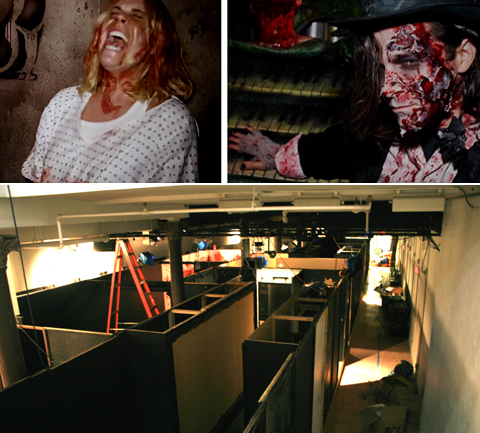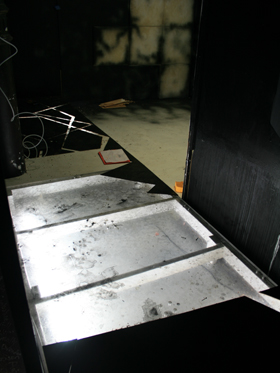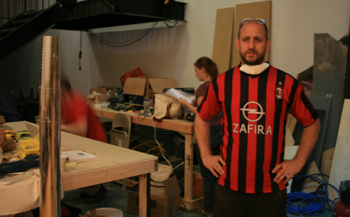
Clockwise, from top left: a mental patient inside the “Nightmare: Superstitions” haunted house, a resident of “Blood Manor” and a peek into the labyrinth of rooms at Nightmare
At 623 Broadway, it’s hard to avoid the confined spaces, falling ladders and floors that buckle beneath your feet.
It would be a building inspector’s nightmare, if it were real.
But at the “Nightmare: Superstitions” haunted house in Soho, treading the line between mock terror and heady problems with buildings department regulators, while surviving climbing rents, is part of a daily, and booming, business, as it is with virtually all haunted attractions in the city.
Creator Timothy Haskell’s seven-years-and-counting show runs from late September through mid-November, drawing daily crowds of up to 2,500. Haskell’s show, which regularly ranks as one of the best in the nation, is one of a handful in the city, Haskell said, that can a boast month-and-a-half gross revenue of upwards of $1 million.
But the burdens of operating this program, which utilizes a three-month lease that some experts value at around $85,000, have only grown in the market downturn.
“Entertainment tends to do well in times of recession,” Haskell conceded. But his landlord, who had also signed a lease at the space with Haskell in 2009, was feeling even more bullish.
“When we came to the landlord in February [to renew the lease, which began in August], they were still in the ‘wait and see mode,'” Haskell said, noting that the pop-up shop trend has created fiercer competition for short-term space. “Some people will pay outrageous amounts of money for a convention or a trade show.”
He ultimately signed the lease anyway, but wouldn’t disclose the rent he pays.
Dan Kobin, owner of Absolute Events, a group that coordinates short-term real estate leases, said that landlords for these properties are making a killing in the downturn.
“They’re getting a premium for pop-ups and… hold[ing] out for the right tenant for the long term,” Kobin said, noting that some Soho pop-up locations rake in as much as $100,000 a month.
The challenges of leasing something short-term enough to make Jim Faro, co-owner of Chelsea’s Blood Manor attraction, stick to a more traditional lease. Although his haunted house, which is in its sixth year, operates for about a month, Faro leases his space for the whole year. Faro, who said on peak evenings Blood Manor can see as many as 2,000 guests, would not reveal the rent.
Faro’s landlord declined to comment.
“The haunted house [at 623 Broadway] put me out of business for two months,” Kobin added. “All these people call me [about the space] and I say ‘sorry, we can’t even talk till after November.'”

An illuminated floor under construction at Nightmare
His haunted house, which features permanent installations that are updated each season, has “movie-set” quality scenes, Faro said, which would be difficult to dismantle and reinstall every year. He generates some revenue at other times of the year by opening up Blood Manor to television crews from channels like MTV and Fuse.
But for Haskell, Faro and other haunted attraction proprietors, it’s the non-fiscal hurdles that can require the most fastidiousness. The two face competition from other haunted houses, like Vortex Theater at 115 West 27th Street and the Steampunk Haunted House at 466 Grand Street downtown. They also have to contend with city regulators, who monitor their set construction and use of their space.
Faro said he studies the city’s Department of Building’s list of requirements for passing inspection, which can be challenging for a live, interactive attraction.
“We don’t leave things to chance. We are very cognizant of the details,” Faro said, noting that he often calls city inspectors to “come by before we do something” different to the set.
And with good reason. A DOB inspector can shut down a haunted attraction without warning, if it isn’t up to code, hampering a night’s worth of sales — something Nightmare’s Haskell knows all too well. He chose his current space in part because it was “more regulation-friendly” than his former Lower East Side location at 107 Suffolk Street, which had proven problematic in the past. Regulations include using all fire-retardant materials and providing illuminated exit signs throughout the attraction.
But New York City operators aren’t alone — personal injury lawsuits against haunted attraction operators are on the rise nationwide, according to On Point, a legal news publication. One teenage girl in Missouri claimed that an improperly used fog machine induced an asthma attack, while another patron in Illinois sued a different haunted house when her feet became entangled in rubber mats.

Nightmare creator Timothy Haskell oversees set construction
Haskell said he’s aware of the hazards and has taken steps to ensure a spooky time that’s also up-to-code. To simulate the feeling of confined spaces, he installs walls that continuously inflate “like a lung.” To make patrons stumble — without literally knocking them down — he uses disorienting lights.
A spokesperson for DOB wouldn’t confirm whether haunted houses are more at risk for violations than other businesses, noting that “safety concerns at any property are taken very seriously” by the DOB.
